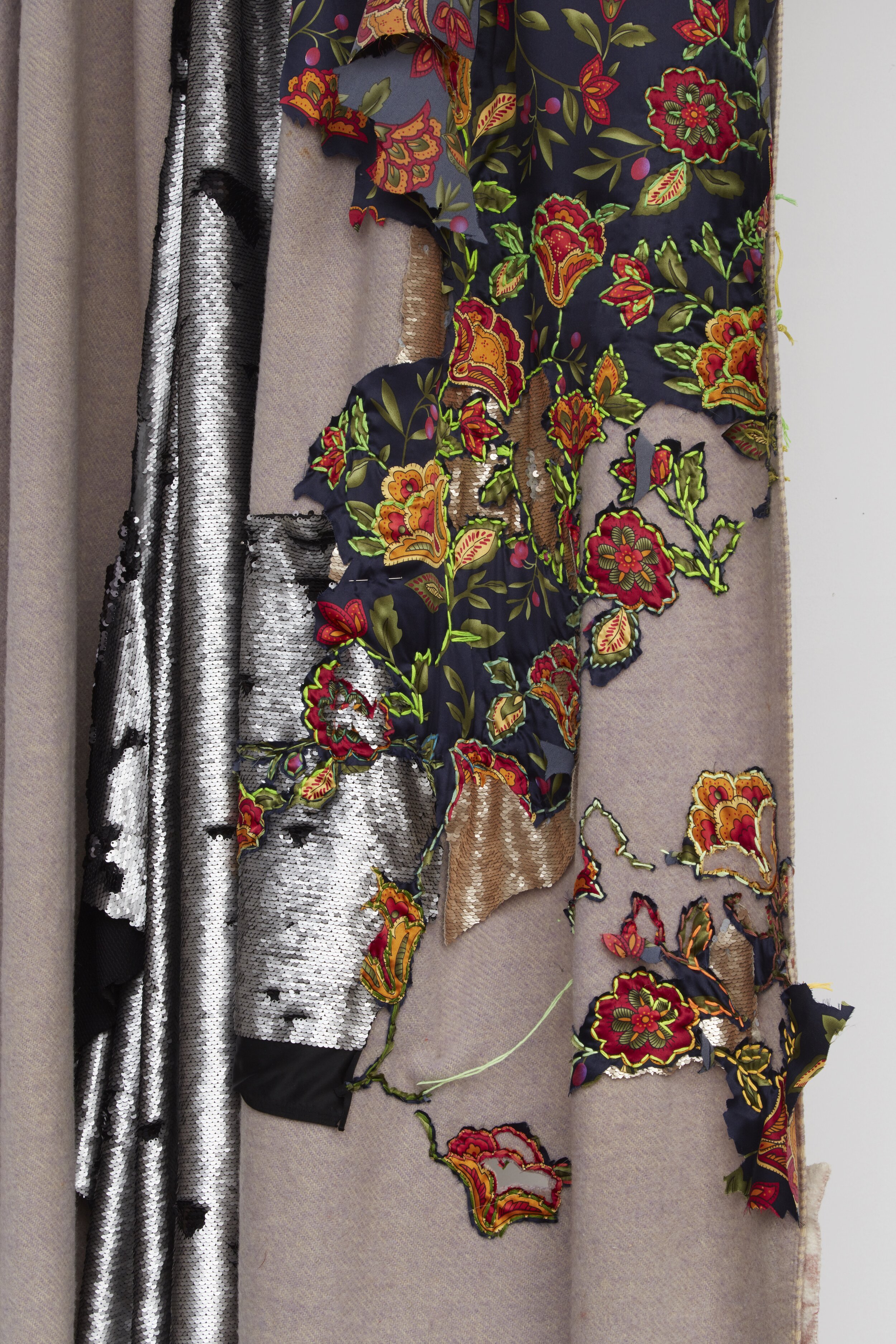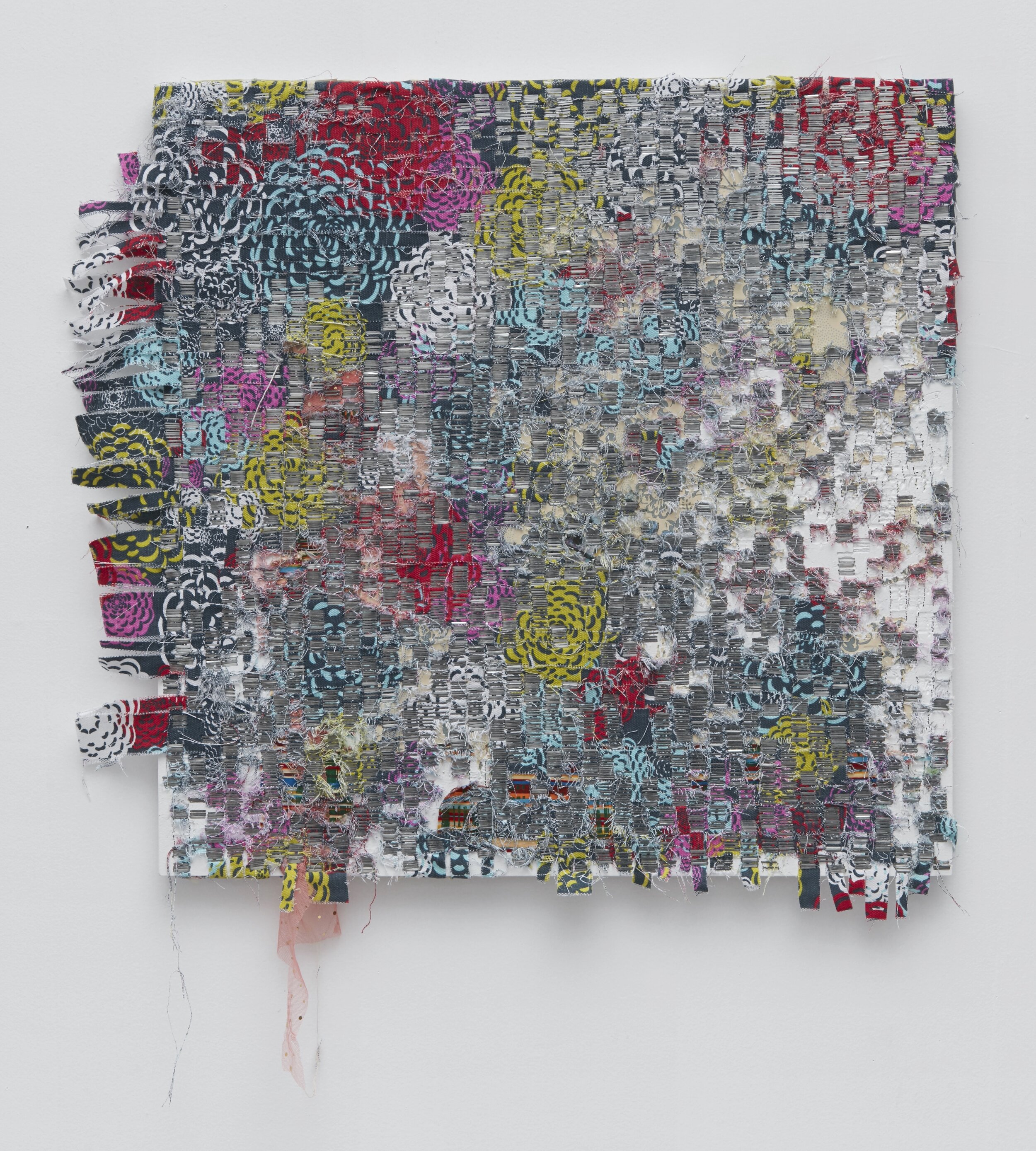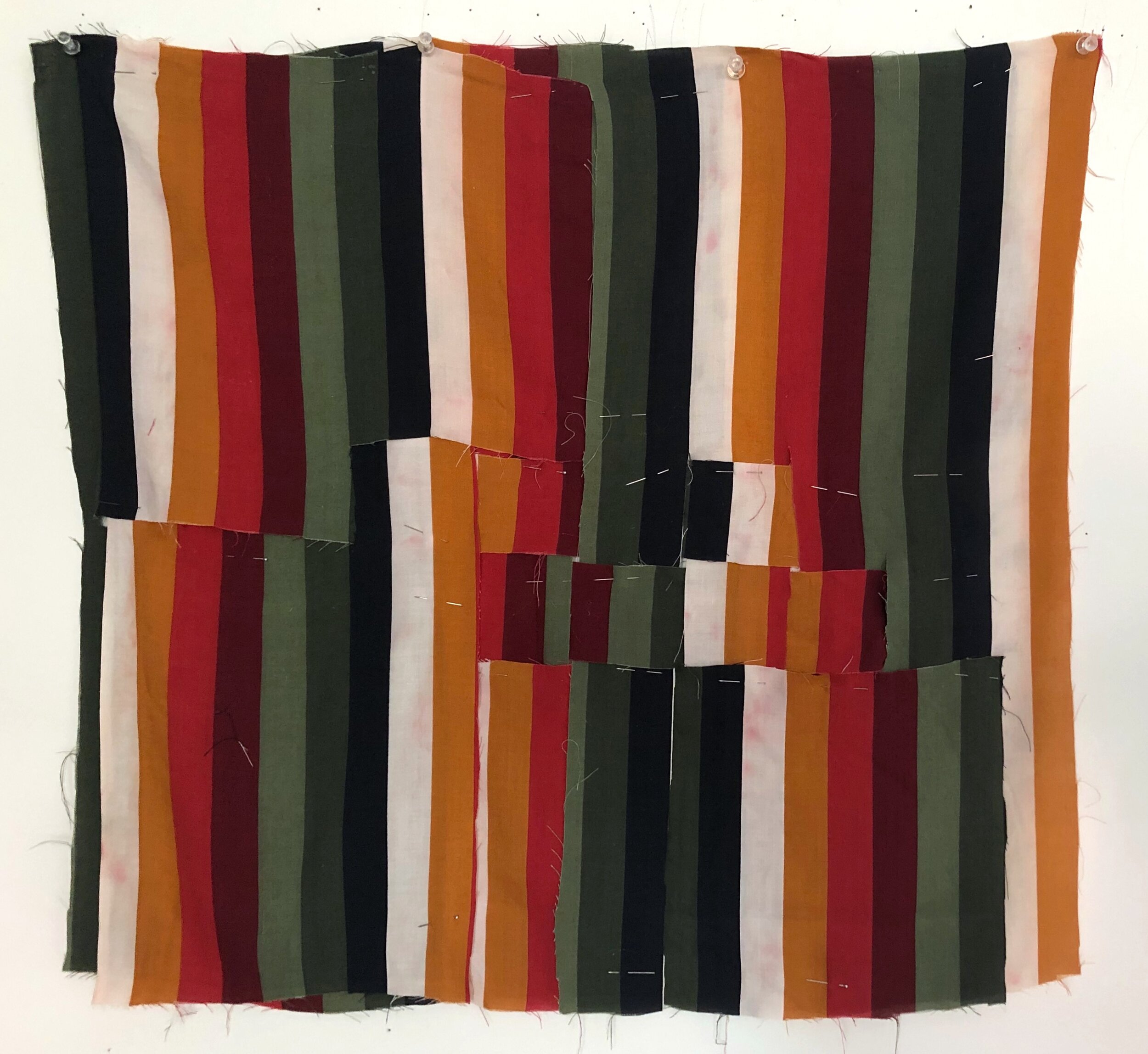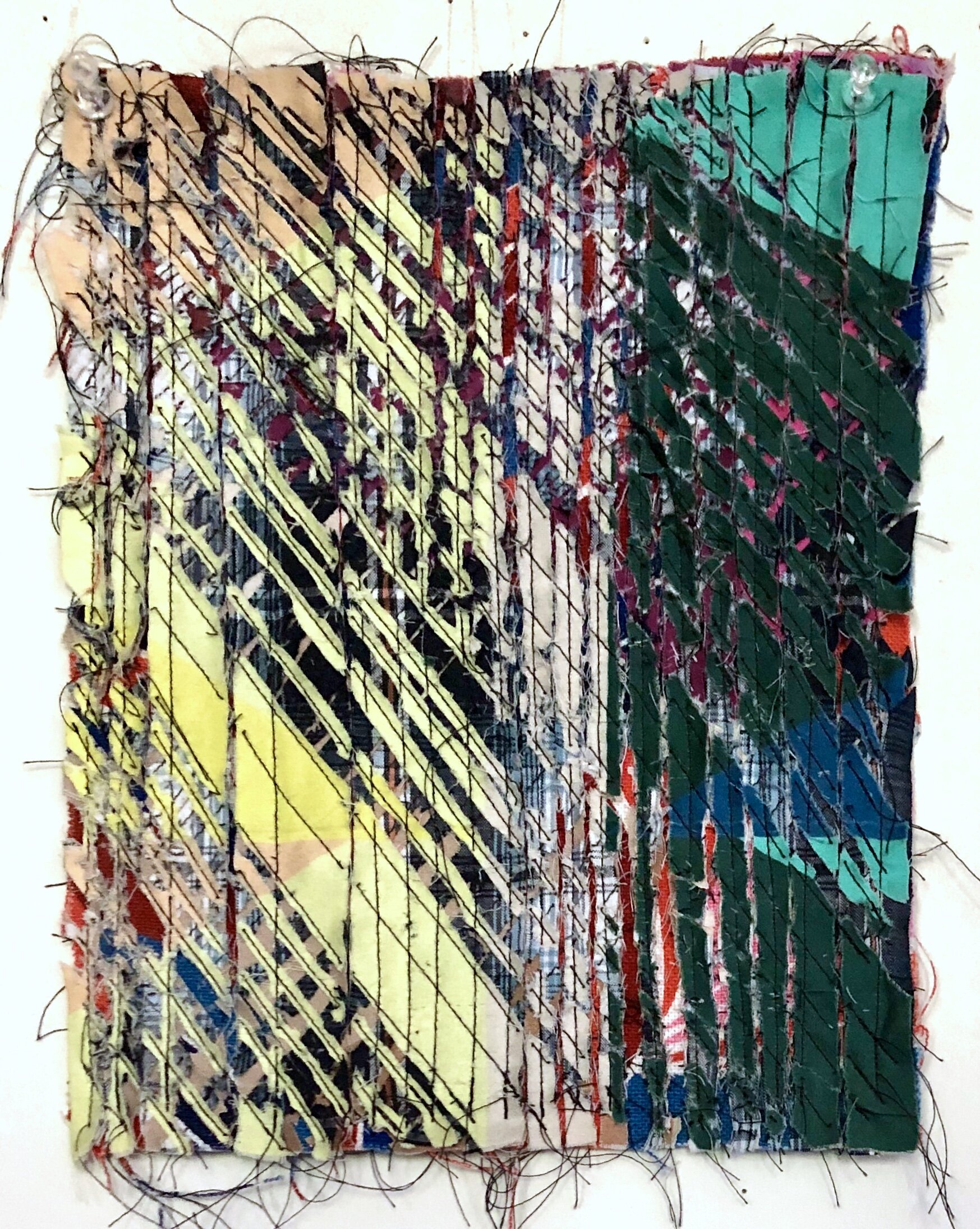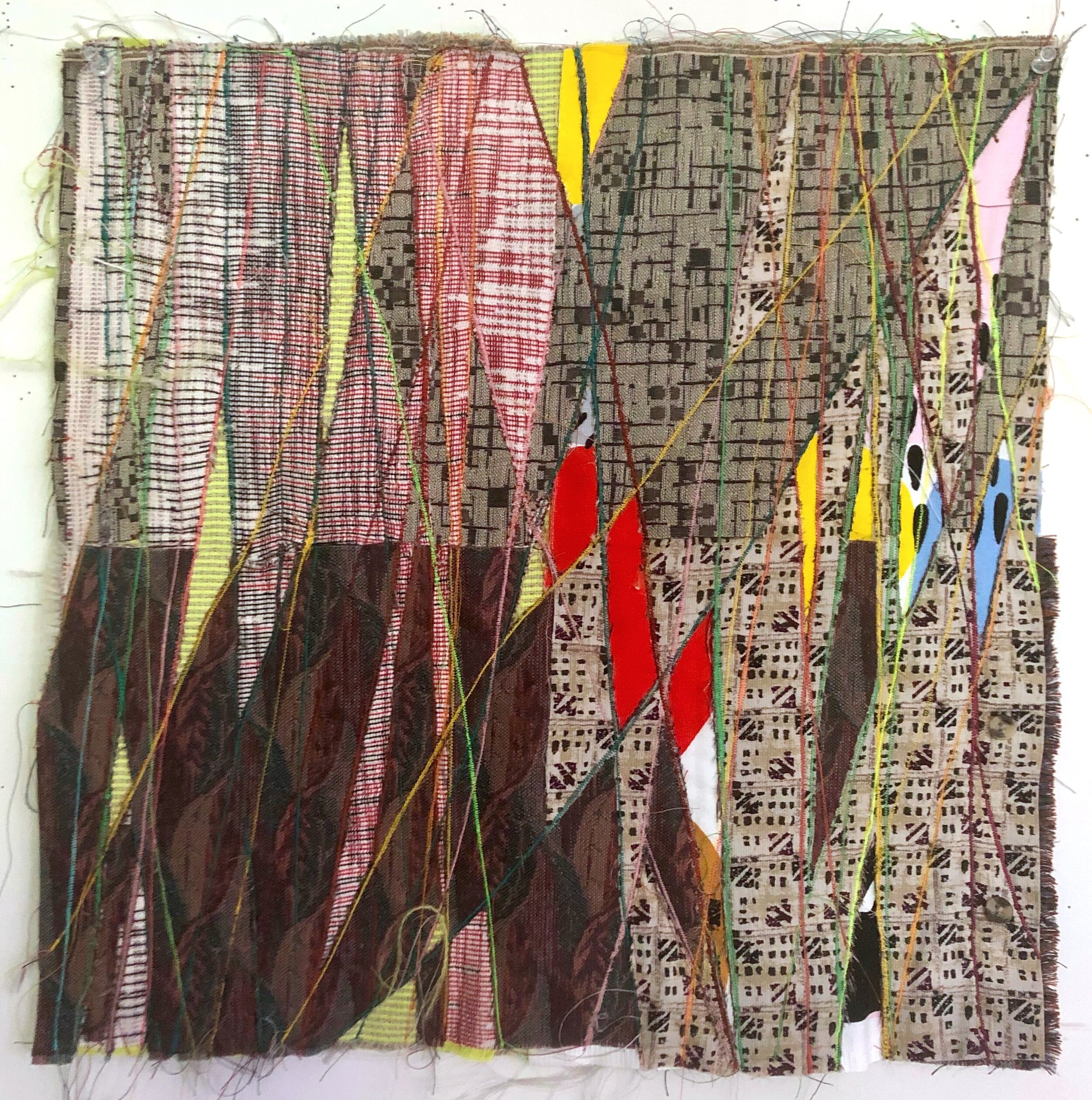Elana Herzog uses material culture to consider aspects of ephemerality, entropy, pleasure and pain. Her current focus is on the global migrations of culture and technology as seen through the lens of textile. When she travels she researches the ways that people and materials relocate, transforming domestic and institutional environments over time.
Herzog has exhibited widely in the US and abroad. She has attended residencies, including at the MacDowell Colony, Yaddo, and the Albers Foundation. Herzog has received a Guggenheim Fellowship. the Anonymous Was A Woman Award, the Louis Comfort Tiffany Award, the Joan Mitchell Award and two NYFA awards.
For more information, please see: www.elanaherzog.com and on Instagram @elanaherzog.
Elana Herzog, Cross Pollinations 2, 2020. Cut fragments of wooden crate, miscellaneous lumber, mixed textiles sourced in Norway, Russia and New York, embroidery floss, hardware, nylon cord. Dimensions variable, this installation: 144 x 88 x 45 inches. Photo: Alan Wiener.
Elana Herzog, Cross Pollinations 2 (detail), 2020. Cut fragments of wooden crate, miscellaneous lumber, mixed textiles sourced in Norway, Russia and New York, embroidery floss, hardware, nylon cord. Dimensions variable, this installation: 144 x 88 x 45 inches. Photo: Alan Wiener.
First, and most importantly, how are you doing? How are you navigating the highs and lows?
I have felt extremely lucky to be an artist during these past months, and accustomed to hours of solitary work that is intrinsically satisfying. I’m grateful for whatever mysterious inner drive motivates me. This time has been an amazing opportunity for reflection. I’m usually a fairly social person, so it was interesting to see myself thrive in seclusion and enjoy a much more simplified lifestyle. These pleasures are functions of privilege, to be sure; being able to work at home, financially secure, healthy and with no small children to care for. No, I’m not happy all the time, but I’m trying to see these challenges as sources of strength.
At first I was fascinated by the way the spread of the virus seemed to echo global trade routes; logically enough, and already of interest to me re the textile trade. The pandemic quickly revealed cracks in political and economic power structures, and raised issues around the sustainability of the status quo, and sustainability more broadly. Whatever poetic justice I saw in this upset was shattered as the inequities of its impact became more.
Elana Herzog, Untitled 2, 2001. Cotton chenille bedspread, metal staples, drywall, plywood. 91.5 x 84 inches. Photo: Kevin Sisemore.
Elana Herzog, Romancing the Rock, 2010. Textiles and metal staples in two sides of a drywall cube. 96 x 96 x 96 inches. Photo: Arthur Evans.
Are you thinking differently? Coping differently? Inspired differently?
I’ve started to collaborate with a friend on a public project. We both see this as an opportunity to connect with each other and overcome the isolation of lock down. We live in different boroughs, so meeting to do site visits requires a pilgrimage of crossing the East River that involves long walks and occasional ferry rides. The challenge of getting around and satisfying our most basic needs informs our project. Connectivity is central to our concept, and under these extraordinary circumstances that takes on greater significance than ever.
I live in a 4th floor walkup apartment in the East Village, and my studio is in Brooklyn. Because I’ve been reluctant to ride the subway since March, I’ve been working mainly at home in my living room. I’m working on a small scale, with lightweight materials, and without noisy power tools. I started using a sewing machine for the first time since the 1990s. I’ve loved doing this small work, but I miss “large muscle” activities. Luckily I’ve been able to garden in the rear yard of my building, and am doing some work on the apartment, both of which have been great outlets for my urges to dig holes, climb up and down ladders. Beyond that, long walks along the East River have and in a few other directions been a relief too. I feel more connected to my neighbors and my neighborhood than ever before, which is actually kind of nice.
Elana Herzog, Sampler #1, 2017. Textile, metal straight pins. 16.5 x13.75 inches. Photo: Alan Wiener.
Elana Herzog, Embedded Sampler, 2020. Textile, metal staples in panel. 30 x 27 inches. Photo: Alan Wiener.
It would be great if you could briefly talk us through your practice.
I’ve come to realize that a through line within my work over many years is my use of a succession of additive and subtractive actions that reveal and transform relationships between their elements. My pieces are often produced by layering; a relentless process of accumulation and excavation, inscription and re-inscription. For much of the last twenty years I’ve embedded (and then deconstructed) found textiles into various surfaces, including gallery walls, movable panels and mixed media constructions, using thousands of metal staples. My installations are produced by a mix of rigorous hard work and playful, context-sensitive experimentation, in which labor-intensive "making" and “unmaking” is ultimately subsumed into a final product that almost seems to dissolve.
From about 1999 until 2010 this was all I wanted to do, and I did a lot of it. Since 2010, I’ve begun to make pieces that are more mobile. In 2008, in connection with a project I did in Boone, North Carolina, I began researching US textile history and production in relation to issues of labor, industry and globalization. Since that time my thinking continues to follow along these lines and has expanded to include colonialism and migration as well as other aspect of geopolitics and culture. Travel has become increasingly important to me, both for research, and to attend residencies. A practice that is lighter and more portable makes travel possible. This has resulted in works that are both large and small, but fundamentally mobile, and sometimes with migration itself as a conceptual underpinning. In 2012, I started what turned out to be an ongoing project called Material Migrations in which I move carpets from place to place to form large temporary floor and wall installations. I picked up new material at each stop, and left some behind. Ironically, two of these projects were scheduled for spring 2020, and have been postponed due to COVID 19.
In 2015, I incorporated the wooden shipping pallet on which some of my materials had traveled from New York City to Sharjah on into the version of Material Migrations that I made there, and in 2016 and 2017 I began making sculptures using shipping pallets and my own recycled art shipping crates.
On the small side, Samplers began in 2017 as a series of intimate pieces in which I layer two small identical squares of fabric — cut horizontal strips in one and vertical strips in the other, and then weave them back together. Theoretically this process should reconstruct the original pattern exactly, but it never quite does; a degree of irregularity results from freehand cutting and weaving, and the process of attempting to force two layers of material into the space of one. The incrementally displaced pattern results in a new image. I was first inspired by a piece of mass produced cloth that I’d brought back from Indonesia with a printed pattern of overlapping chrysanthemums, and, intrigued by these largely unpredictable outcomes I’ve gone on to subject a lot of fabric to this process. I’ve followed my curiosity into new places that involve scanning, printing, stapling, sewing and cutting. The stapled Samplers further deconstruct the original matrix and reconnect it to my own history of making and unmaking. The sewing machine, which I started using during lockdown allows for new structural possibilities, and deconstructive processes.
Elana Herzog, Valence, 2014. Wood, drywall, paint, textile, metal staples, steel shelving posts, hardware. 240 x 360 x 48 inches. Installation view at The Boiler (Pierogi), Brooklyn, New York. Photo: Alan Wiener.
Elana Herzog, Untitled, 2016. Wooden shipping pallet, carpet scrap. 16 x 48 x 40 inches. Photo: Alan Wiener.
Are you reading anything?
I’ve listened to a lot of books on tape. Early on I heard Robin Wall Kimmerer’s Braiding Sweetgrass, and some historical fiction by Amitav Ghosh and Hillary Mantell. Then moved on to The Nickel Boysby Colson Whitehead, The Good Lord Bird by James MacBride, How To Be An Antiracistby Ibram X. Kendi, and Kindredby Octavia Butler.
Elana Herzog, Today at Noon, 2020. Textile, straight pins. 21 x 23 inches. Image courtesy of the artist.
Elana Herzog, Sunday Morning, 2020. Mixed textiles, thread. 11 x 9 inches. Image courtesy of the artist.
Elana Herzog, Monday, June 22nd, 2020. Mixed textiles, thread. 19 x 19 inches. Image courtesy of the artist.


